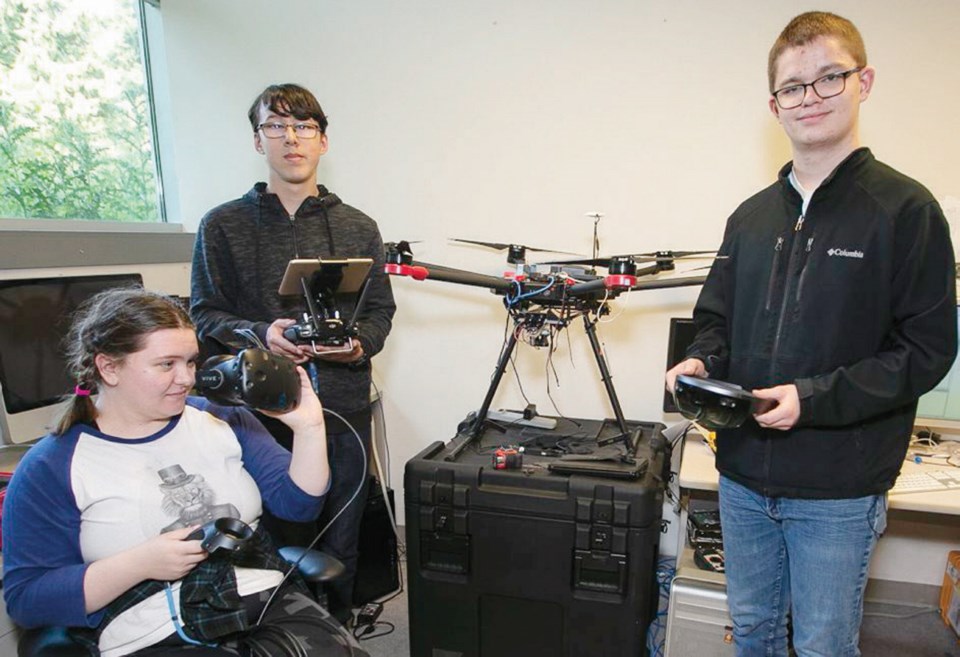Small-town Native teenager Ayianna Johnson hails from B.C. Interior and has travelled frequently to Vancouver, even to China with a school friend. So she is no stranger to culture shock.
But the 16-year-old Johnson found herself easily settling in among the visible presence of Indigenous life and culture at the University of Victoria: carvings, totem poles, artwork and the First People’s House
“It really makes me feel at home, all the traditional culture, the totem poles the Native history,” said Johnson, is from the Carrier Nation in Tachet, population 200.
She and nine other small-town Indigenous students have just completed on Friday a five-day visit to the University of Victoria to gain a glimpse of lab work, science and university life. Johnson said her interest is in medicine but she was thrilled with the chance to explore physics and astronomy at UVic.
Johnson and her young compatriots were all part of UVic’s first move into the 10-year-old Verna J. Kirkness Science and Engineering Program. The program brings Indigenous high-school students to universities for five-day field trips.
It now counts eight other Canadian universities participating. Most are in Western Canada. The University of Ottawa is also taking part. Queens and McGill are interested.
Participating young people spend their time on campus, living in residence and gain some close-up peeks at science and engineering research work, courses and campus life.
It’s free for the young people, with expenses paid for by the charitable Verna J. Kirkness Foundation, founded in 2008. So far, 525 Indigenous Grade 11 students, from 109 small, often isolated communities have taken part and been introduced to science and engineering at the university level.
Verna J. Kirkness, now in her 80s, a life-long educator and a member of the Fisher River Cree Nation in Manitoba, was asked to lend her name to the program and said she was honoured to be involved.
Kirkness said young people from First Nations, Métis and Inuit backgrounds are enrolling in post-secondary education in increasing numbers in recent years. But the numbers of them pursuing science and technology is low compared to the university population at large. She cites a number of reasons.
“First of all we need good role models and we don’t have many people in the sciences,” she said. “But also smaller high schools like the ones serving First Nations communities often don’t have good labs.”
“That’s why [young people] are so fascinated when they can come to a university,” said Kirkness.
“A real university lab just really encourages them.”
She said the program works entirely by tapping into a university’s professors and graduate students and asking for volunteers to mentor the students during their stays.
“I’ve always been really amazed at that [volunteer] aspect of our program, said Kirkness. “These professors, mentors as we call them, are always so eager to work with our students.”
She said the experience can be the kind of process young people in larger centres take for granted. Sometimes high school students need to experience something to realize it’s not for them and move on.
Morgan Laboucan, 20, of the Driftpile Cree Nation, near High Prairie in northern Alberta, attended a session at the University of Manitoba in 2016 and learned science was not going to be her career of choice.
Laboucan is now entering the third year of a philosophy major at the University of Calgary and is aiming for law.
Laboucan said on her visit to the University of Manitoba she observed scientists using lasers to decipher the biology of a fish from a bone in its skull. Despite her switch to liberal arts, it was not a waste of time.
“When I was in high school, I wasn’t really sure what I wanted to do,” she said. The Kirkness program “made me realize I was not super-interested in fish or rivers or labs.”
Michael Roney, UVic professor of astronomy and physics, said he took a week off from research as director of the Institute for Particle Physics, to mentor the Kirkness visitors and was bowled over by the young people and predicted they will be strong students and future leaders.
“Let’s face it, physics has all kinds of crazy, mind-bending ideas,” said Roney. “But the attention and the questions we were getting were just fantastic, very thoughtful, very engaged.
“I am very excited by the notion that we can bring in people from different backgrounds. They will come up with new ideas because their imaginations will be triggered by different things.
“And imagination is where discovery comes from.”



